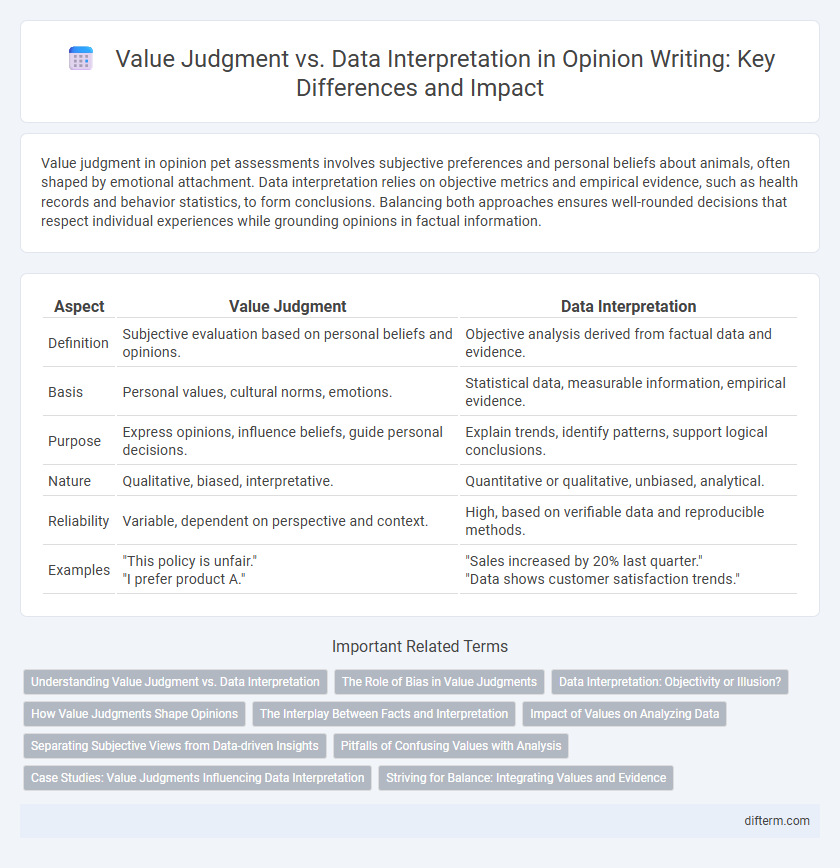Value judgment in opinion pet assessments involves subjective preferences and personal beliefs about animals, often shaped by emotional attachment. Data interpretation relies on objective metrics and empirical evidence, such as health records and behavior statistics, to form conclusions. Balancing both approaches ensures well-rounded decisions that respect individual experiences while grounding opinions in factual information.
Table of Comparison
| Aspect | Value Judgment | Data Interpretation |
|---|---|---|
| Definition | Subjective evaluation based on personal beliefs and opinions. | Objective analysis derived from factual data and evidence. |
| Basis | Personal values, cultural norms, emotions. | Statistical data, measurable information, empirical evidence. |
| Purpose | Express opinions, influence beliefs, guide personal decisions. | Explain trends, identify patterns, support logical conclusions. |
| Nature | Qualitative, biased, interpretative. | Quantitative or qualitative, unbiased, analytical. |
| Reliability | Variable, dependent on perspective and context. | High, based on verifiable data and reproducible methods. |
| Examples | "This policy is unfair." "I prefer product A." |
"Sales increased by 20% last quarter." "Data shows customer satisfaction trends." |
Understanding Value Judgment vs. Data Interpretation
Understanding value judgment versus data interpretation involves recognizing that value judgments are subjective assessments influenced by personal beliefs and cultural norms, while data interpretation relies on analyzing objective information through systematic methods. Value judgments often introduce bias, shaping conclusions based on preference rather than empirical evidence, whereas data interpretation seeks to minimize bias by grounding decisions in quantifiable facts. Distinguishing between these concepts is essential for making informed decisions that balance ethical considerations with factual accuracy.
The Role of Bias in Value Judgments
Value judgments are inherently influenced by personal biases, which shape how individuals prioritize ethical considerations over objective data. Bias can distort the interpretation of facts, leading to conclusions that reflect subjective preferences rather than empirical evidence. Understanding the role of cognitive and cultural biases is crucial to separating personal values from pure data analysis.
Data Interpretation: Objectivity or Illusion?
Data interpretation often claims objectivity, yet it is invariably influenced by the interpreter's perspective, context, and underlying assumptions. Statistical results and patterns can be framed to support varying conclusions, revealing the subjective elements within seemingly objective data. Recognizing this interplay challenges the notion that data interpretation is purely factual, highlighting the importance of critical analysis in evaluating evidence.
How Value Judgments Shape Opinions
Value judgments heavily influence opinions by framing how individuals prioritize information based on personal beliefs and ethical standards. While data interpretation offers objective insights, the subjective lens of value judgments determines which aspects of data are emphasized or dismissed. This interplay shapes not only individual opinions but also public discourse and decision-making processes.
The Interplay Between Facts and Interpretation
Value judgment and data interpretation constantly influence decision-making processes, where objective facts provide a foundation but subjective perspectives shape their significance. Data interpretation involves analyzing raw information to extract meaning, while value judgments assign importance based on personal or cultural beliefs. Understanding the interplay between these elements reveals how biases impact the perception of factual evidence and guide conclusions.
Impact of Values on Analyzing Data
Values significantly influence data interpretation by shaping the questions asked and the conclusions drawn, often introducing bias even in seemingly objective analyses. The subjective lens of value judgment can affect the selection, emphasis, and framing of data, potentially altering the perceived significance and outcomes. Recognizing the impact of values is crucial for transparent and balanced data analysis, ensuring that insights remain as objective and credible as possible.
Separating Subjective Views from Data-driven Insights
Separating subjective views from data-driven insights is crucial for accurate decision-making and objective analysis. Value judgments often rely on personal beliefs and emotions, which can distort the interpretation of empirical data. Emphasizing data-driven insights ensures conclusions are based on measurable evidence rather than individual biases.
Pitfalls of Confusing Values with Analysis
Confusing value judgments with data interpretation risks biasing conclusions and undermines objective analysis. Value judgments introduce subjective preferences that can lead to selective data use or misrepresentation of facts. Clear separation between empirical evidence and personal values is essential for credible, transparent decision-making.
Case Studies: Value Judgments Influencing Data Interpretation
Case studies reveal that value judgments often shape the interpretation of data, leading to biased conclusions aligned with subjective beliefs rather than objective analysis. Researchers' perspectives and cultural contexts frequently influence which data points are emphasized or disregarded, impacting the overall findings and their applicability. Recognizing the interplay between value judgments and data interpretation is crucial for enhancing transparency and credibility in empirical research.
Striving for Balance: Integrating Values and Evidence
Striving for balance between value judgment and data interpretation enhances decision-making by integrating ethical considerations with empirical evidence. Recognizing the influence of personal values ensures that data is not interpreted in isolation but within a context that reflects societal priorities and human impact. This balanced approach promotes more nuanced and responsible conclusions in complex real-world scenarios.
value judgment vs data interpretation Infographic

 difterm.com
difterm.com